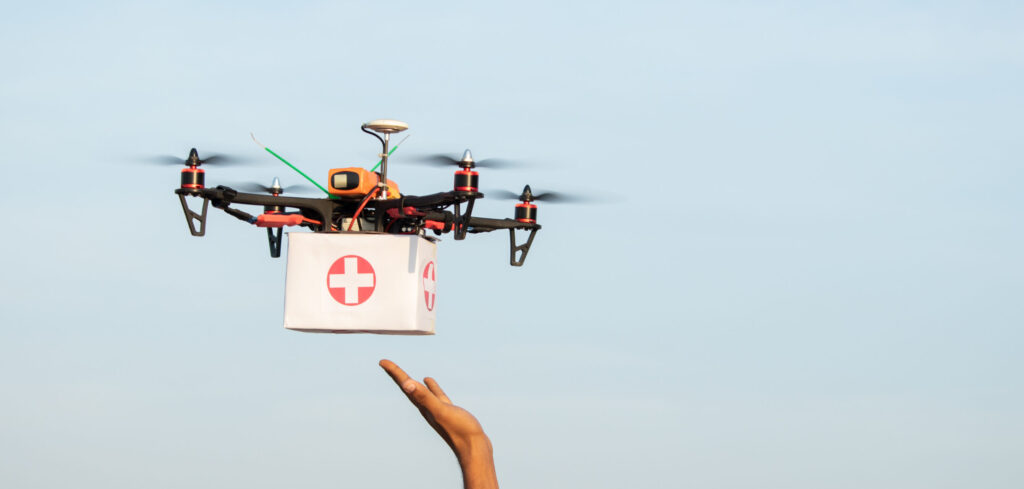As India continues to develop and modernize, the use of drone-based deliveries is quickly becoming a game-changer in the transportation industry. Drone deliveries are changing the landscape of modern India by providing a fast, efficient and cost-effective alternative to traditional transportation methods. From healthcare to e-commerce, drone deliveries have the potential to transform the way businesses and individuals move goods across the country.
Benefits and challenges
One of the main benefits of drone deliveries is that they provide a fast and efficient way to transport goods. With traditional transportation methods, it can take days or even weeks to transport goods across the country. However, with drone deliveries, goods can be transported across the same distances in a matter of hours. This is especially important for industries like healthcare, where time is of the essence and delays can have serious consequences.
Another advantage of drone deliveries is that they can reach remote and hard-to-reach areas that are difficult or impossible to access with traditional transportation methods. In India, there are many areas that are difficult to access due to poor infrastructure and challenging terrain. However, with drone deliveries, goods can be transported to these areas quickly and efficiently, improving the lives of the people living there.
Drone deliveries are also more cost effective than traditional transportation methods. With fuel costs and maintenance expenses rising, drone deliveries can help businesses save money on transportation costs. This is especially important for small businesses that may not have the resources to invest in expensive transportation infrastructure.
In addition to being fast, efficient and cost-effective, drone deliveries are also environmentally friendly. With concerns about climate change and environmental sustainability growing, the use of drones for deliveries is an excellent way to reduce the carbon footprint of the transportation industry. Drone deliveries use much less fuel than traditional transportation methods, making them a more sustainable option.
Despite these benefits, there are also challenges that come with the use of drones for deliveries. One of the biggest challenges is the need for infrastructure to support drone operations. This includes landing pads, charging stations and control centers. The development of this infrastructure will require significant investment and planning.
Transforming healthcare delivery
The drone delivery industry in India is poised for significant growth in the coming years. According to a report by TechSci Research, the Indian drone market is expected to reach US$1.8bn by FY 2026, growing at a CAGR of 14.61%. This growth is being driven by factors such as government support, advances in drone technology and the need for faster and more efficient transportation methods.
In recent years, there has been a growing interest in using drones for delivering medical supplies, including vaccines, blood samples and medicines, to remote and hard-to-reach areas in India. The use of drones for healthcare delivery is particularly important in India, where most of the population lives in rural areas with limited access to healthcare services. In such areas, drone-based delivery can help save lives by ensuring timely delivery of medical supplies.
One of the biggest advantages of drone deliveries in healthcare is speed. Drones can transport medical supplies much faster than traditional modes of transportation, such as road or rail. This is especially critical in emergency situations where time is of the essence. Moreover, drones can reach areas that are inaccessible to ground transportation due to poor infrastructure, natural disasters or geographical barriers.
However, the use of drones in healthcare delivery comes with its own set of challenges. One of the main concerns is safety, both in terms of air traffic safety and the safety of the medical supplies being transported. Drones must be operated in a responsible and safe manner, and appropriate regulatory frameworks around traffic management must be in place to govern their operations.
Despite the challenges, the potential for drone-based healthcare delivery in India is enormous. With the right infrastructure, regulations and policies in place, drone-based delivery could revolutionize the way medical supplies are transported and delivered in the country, ultimately saving countless lives and improving the health and well-being of millions of people.
In conclusion, drone deliveries are revolutionizing the landscape of modern India by providing a fast, efficient and cost-effective alternative to traditional transportation methods. With the ability to reach remote and hard-to-reach areas and reduce the carbon footprint of the transportation industry, drone deliveries have the potential to transform the way businesses and individuals move goods across the country. While there are challenges that need to be addressed, the growth potential of the drone delivery industry in India is significant, and we can expect to see even more benefits in the years to come.


